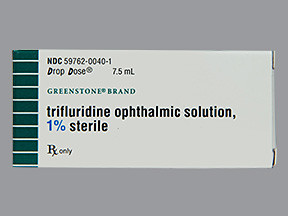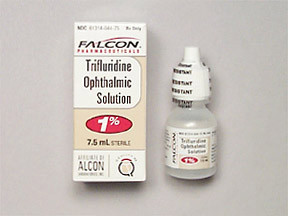TRIFLURIDINE DROPS - OPHTHALMIC
PHONETIC PRONUNCIATION: (try-FLEWR-ih-deen)
COMMON BRAND NAME(S): Viroptic
GENERIC NAME(S): trifluridine
Uses
USES: This medication is used to treat herpes infection of the eye. Herpes is a virus that lives in the body quietly until an outbreak is triggered. Trifluridine is not a cure for the infection, but treatment of an outbreak can speed up the healing of the sores/swelling in the eye and lower the risk of complications (e.g., vision loss).
How to use TRIFLURIDINE DROPS - OPHTHALMIC
HOW TO USE: To apply eye drops, wash your hands first. To avoid contamination, do not touch the dropper tip or let it touch your eye or any other surface. Tilt your head back, look up, and pull down the lower eyelid to make a pouch. Hold the dropper directly over your eye and place 1 drop into the pouch as directed by your doctor. Look down and gently close your eyes for 1 to 2 minutes. Place one finger at the corner of your eye (near the nose) and press gently. This will prevent the medication from draining out. Try not to blink and do not rub your eye. Repeat these steps for your other eye if so directed. Do not rinse the dropper. Replace the dropper cap after each use. Use this medication usually every 2 hours while awake until the eye has healed. Do not use more than 9 drops into the eye in a 24-hour period. After healing, use this medication for another 7 days, usually every 4 hours while awake (at least 5 drops per day) or as directed by your doctor. If you are using another kind of eye medication (e.g., drops or ointments), wait at least 5 to 10 minutes before applying other medications. Use eye drops before eye ointments to allow the drops to enter the eye. Use this medication regularly in order to get the most benefit from it. To help you remember, use it at the same times each day. Continue using it for the full time prescribed. Stopping the medication too early may result in a return of the infection. Do not use this medication more often or use longer than prescribed because doing so may increase the risk of side effects. This medication should not be used for more than 21 days at a time. Tell your doctor if your condition worsens, does not improve after 7 days, or does not completely heal after 14 days.
Side Effects
Precautions
Interactions
Overdose
Images
Reviews
Faq for TRIFLURIDINE DROPS - OPHTHALMIC
Trifluridine drops are used to treat viral infections of the eye, specifically herpes simplex keratitis.
Trifluridine is an antiviral medication that works by preventing the growth and replication of the virus in the eye.
You should follow the instructions provided by your doctor or pharmacist. Typically, trifluridine drops are used 9 times a day for 7 to 9 days, and then the frequency is gradually reduced.
Common side effects include stinging or burning of the eye, blurred vision, eye irritation, and increased tear production. Contact your doctor if you experience severe side effects such as eye pain or swelling.
Yes, trifluridine drops can be used in children. However, the dosage may be adjusted based on their age and weight.
It is not recommended to wear contact lenses while using trifluridine drops as they may absorb the medication and reduce its effectiveness. Wait at least 15 minutes after using the drops before reinserting contact lenses.
Trifluridine drops may start working within a few days, but it is important to complete the full course of treatment as prescribed by your doctor.
It is advisable to consult with your doctor before using trifluridine drops during pregnancy or while breastfeeding, as the potential risks and benefits need to be assessed.
If you miss a dose, use it as soon as you remember. However, if it is almost time for your next dose, skip the missed dose and continue with your regular dosing schedule. Do not double the doses.
Disclaimer
IMPORTANT: HOW TO USE THIS INFORMATION: This is a summary and does NOT have all possible information about this product. This information does not assure that this product is safe, effective, or appropriate for you. This information is not individual medical advice and does not substitute for the advice of your health care professional. Always ask your health care professional for complete information about this product and your specific health needs.



No Reviews Yet